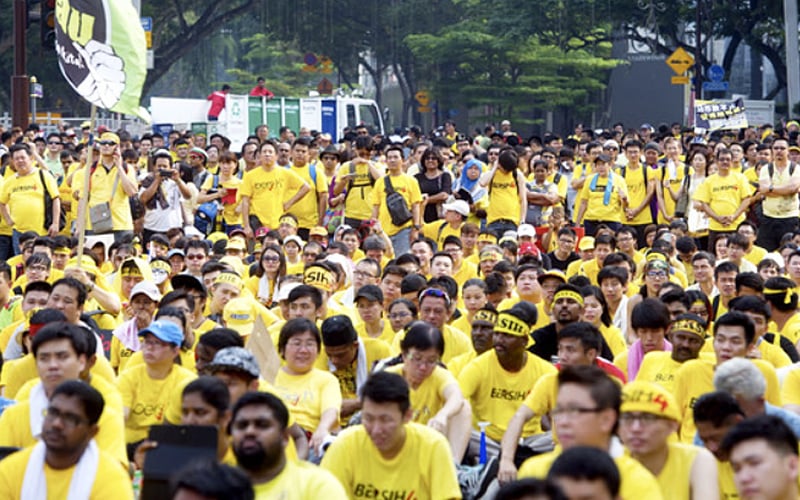
From Kua Kia Soong
It is gratifying to see the new Bersih leadership once again taking up the challenge of seeking the elusive reforms civil society has demanded since the 14th general election (GE14) in 2018.
It is truly nauseating to see our beloved country trundling along with a lacklustre economy and a compromised political system that still relies on the colonial Sedition Act, while refusing to bring back elected local governments.
While Bersih’s original demands centred on free and fair elections, there was no doubt that the motivation behind the protests was the desire to see real reforms.
The first rally of tens of thousands at Dataran Merdeka in Kuala Lumpur in 2007 influenced the 2008 general election, when Barisan Nasional (BN) failed to obtain a two-thirds majority for the first time since 1969.
The second rally on July 9, 2011, was organised to protest alleged vote rigging and other electoral abuses in the Sarawak elections in April 2011.
In early April 2012, a parliamentary select committee released a report of its findings on electoral reform, which was passed in the Dewan Rakyat and ignored Bersih’s demands.
This and the unfolding 1MDB scandal led to Bersih calling for a third rally on Aug 29-30, 2015.
Thus, Bersih’s demands were no longer just confined to free and fair elections, they included clean government, the right to dissent, strengthening parliamentary democracy, saving the economy, and the resignation of then prime minister Najib Razak, who was at the centre of the 1MDB scandal.
When former prime minister Dr Mahathir Mohamad was made the leader of the so-called Save Malaysia campaign, he shared the stage with Bersih leaders, and went on to become the first Pakatan Harapan (PH) prime minister.
However, Mahathir, as the head of the supposedly reform movement, was a bare-faced opportunist. Some have said it was like putting the fox in the hen house.
Bersih ‘embourgeoisement’ after PH came into power
In May 2018, Malaysians elected a PH government, putting an end to 61 years of a single party’s monopoly on power.
It also seemed to take the wind out of Bersih’s activist zeal. Two years later, the reforms we had eagerly awaited from Reformasi leaders had yet to materialise.
Meanwhile, some Bersih leaders were co-opted into various commissions and other plum jobs in the government, supposedly “reform committees”, but the reports they produced were embargoed under the Official Secrets Act.
Sociologists might put it down to “embourgeoisement” of the Bersih leaders, a process by which radicals adopt middle-class values once their backers are in power.
As events unfolded after 2018, PH became more and more like BN 2.0, especially with the assimilation of Umno MPs into Mahathir’s Bersatu party.
This short rule by PH ambled along, failing to meet manifesto promises and voter expectations in numerous ways.
We witnessed flip-flops over the PH promise to abolish toxic institutions and laws, such as the Security Offences (Special Measures) Act (Sosma) 2012 and other detention-without-trial laws.
PH also failed to focus on the most comprehensive reforms championed by civil society. On top of all that, we saw a disturbing trend of autocratic decisions and policies symptomatic of the old Mahathir era.
Then of course, in 2020, the asinine Sheraton Move took place and PH found itself in the opposition again.
As expected, Bersih leaders were roused from their three-year slumber and vowed to take to the streets again to “fight the system” and to “display their dissatisfaction”.
That was when I posed this question: “Is Bersih a people’s front or a PH front?”
Then in 2022, GE15 lumbered us with a unity government, an alliance which included the BN we had endured for 61 years.
Can there be real reforms when the deputy prime minister is someone who faced no less than 47 charges for corruption; when there is no inclination to bring back local council elections; and when the colonial-era Sedition Act is still used as a weapon of intimidation?
For a while, some PH-friendly Bersih leaders argued for working within the establishment instead of taking direct action.
Yet, fortunately, Bersih’s new leaders appear to be taking the movement back to a peoples’ front, leading the struggle for real reforms.
In hindsight, with more space for sober reflection, it is high time Bersih is clear about the kind of society we want.
Just two demands for a two-term prime minister and abolition of the Sedition Act are insufficient. We will be falling for the same mistake of the earlier Bersih myopic demand for just clean and fair elections.
Voters deserve a meaningful and specific proposal that can lead to substantive changes that go beyond slogans such as “Save Malaysia”, “Save the economy” and other fluffy concepts.
It is time for the Reformasi and Bersih movements to regroup under a concrete reform agenda that is committed to a progressive alternative to the BN and PH coalitions. These must include:
1. People-centred sustainable development
2. Equitable redistribution of wealth
3. Needs-based, not race-based policies
4. Greater democracy, including elected local government
5. A progressive economic policy
6. Defending human rights and the rule of law
7. Zero tolerance for corruption
8. A far-sighted and fair education policy
9. An improved public healthcare system
10. A caring social policy
11. Prioritising Orang Asal rights and livelihood
12. Defence cuts and a culture of peace
Now Bersih is ready to march again, the fight for greater democracy seems to be alive again, so there is cause for hope.
Viva la Bersih! Viva la Reformasi! - FMT
Kua Kia Soong is an academic and former MP.
The views expressed are those of the writer and do not necessarily reflect those of MMKtT.
No comments:
Post a Comment
Note: Only a member of this blog may post a comment.